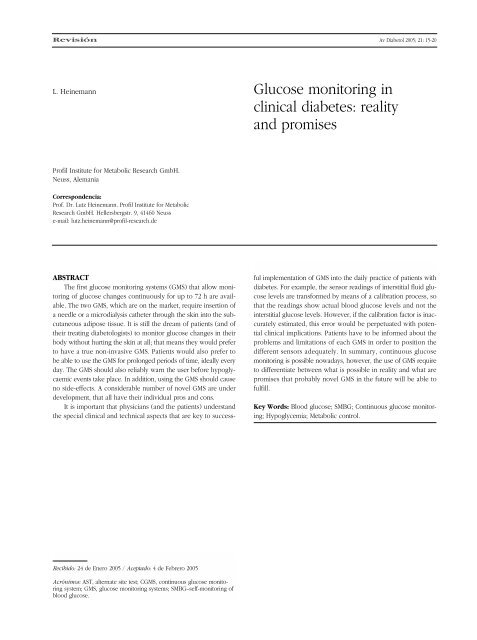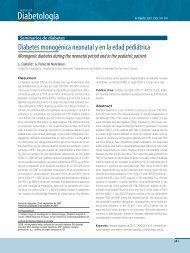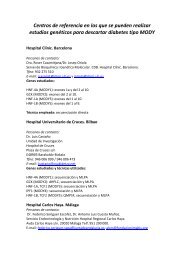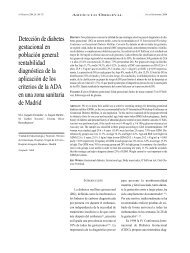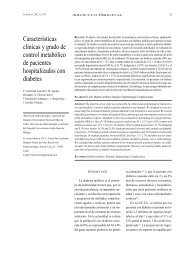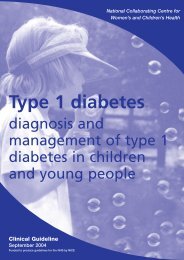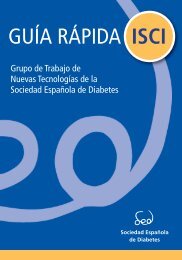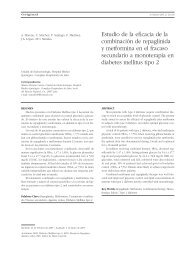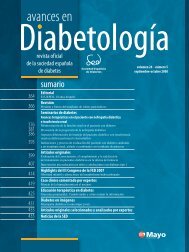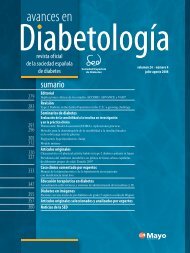Avances en DiabetologÃa - Sociedad Española de Diabetes
Avances en DiabetologÃa - Sociedad Española de Diabetes
Avances en DiabetologÃa - Sociedad Española de Diabetes
- No tags were found...
Create successful ePaper yourself
Turn your PDF publications into a flip-book with our unique Google optimized e-Paper software.
Revisión Av Diabetol 2005; 21: 15-20L. Heinemann Glucose monitoring inclinical diabetes: realityand promisesProfil Institute for Metabolic Research GmbH.Neuss, AlemaniaCorrespond<strong>en</strong>cia:Prof. Dr. Lutz Heinemann. Profil Institute for MetabolicResearch GmbH. Hellersbergstr. 9, 41460 Neusse-mail: lutz.heinemann@profil-research.<strong>de</strong>ABSTRACTThe first glucose monitoring systems (GMS) that allow monitoringof glucose changes continuously for up to 72 h are available.The two GMS, which are on the market, require insertion ofa needle or a microdialysis catheter through the skin into the subcutaneousadipose tissue. It is still the dream of pati<strong>en</strong>ts (and oftheir treating diabetologists) to monitor glucose changes in theirbody without hurting the skin at all; that means they would preferto have a true non-invasive GMS. Pati<strong>en</strong>ts would also prefer tobe able to use the GMS for prolonged periods of time, i<strong>de</strong>ally everyday. The GMS should also reliably warn the user before hypoglycaemicev<strong>en</strong>ts take place. In addition, using the GMS should caus<strong>en</strong>o si<strong>de</strong>-effects. A consi<strong>de</strong>rable number of novel GMS are un<strong>de</strong>r<strong>de</strong>velopm<strong>en</strong>t, that all have their individual pros and cons.It is important that physicians (and the pati<strong>en</strong>ts) un<strong>de</strong>rstandthe special clinical and technical aspects that are key to successfulimplem<strong>en</strong>tation of GMS into the daily practice of pati<strong>en</strong>ts withdiabetes. For example, the s<strong>en</strong>sor readings of interstitial fluid glucoselevels are transformed by means of a calibration process, sothat the readings show actual blood glucose levels and not theinterstitial glucose levels. However, if the calibration factor is inaccuratelyestimated, this error would be perpetuated with pot<strong>en</strong>tialclinical implications. Pati<strong>en</strong>ts have to be informed about theproblems and limitations of each GMS in or<strong>de</strong>r to position thediffer<strong>en</strong>t s<strong>en</strong>sors a<strong>de</strong>quately. In summary, continuous glucosemonitoring is possible nowadays, however, the use of GMS requireto differ<strong>en</strong>tiate betwe<strong>en</strong> what is possible in reality and what arepromises that probably novel GMS in the future will be able tofulfill.Key Words: Blood glucose; SMBG; Continuous glucose monitoring;Hypoglycemia; Metabolic control.Recibido: 24 <strong>de</strong> Enero 2005 / Aceptado: 4 <strong>de</strong> Febrero 2005Acrónimos: AST, alternate site test; CGMS, continuous glucose monitoringsystem; GMS, glucose monitoring systems; SMBG–self-monitoring ofblood glucose.


